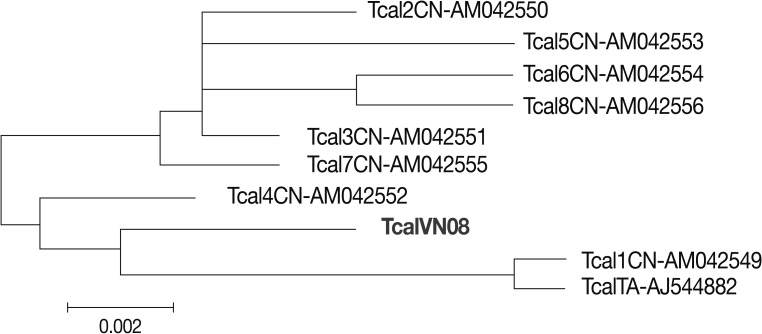INTRODUCTION
Zoonotic parasites are widespread in the world, especially in Asian countries, including Vietnam. Thelazia callipaeda Railliet and Henry, 1910 (Nematoda: Thelaziidae) is a nematode parasite in the genus Thelazia [1]. This nematode is zoonotic and parasitic in the eyes as implied by its name "oriental eyeworm" or "eyeworm". It was reported for the first time from a dog in Pakistan in 1910, and later shown to be widespread in China, France, Germany, India, Indonesia, Italy, Japan, Korea, the Netherlands, Russia, Switzerland, Taiwan, Myanmar, and Thailand [2]. The final hosts include dogs and cats, but occasionally rabbits, monkeys, raccoons, dogs, foxes, wolves, and humans can also serve as the final host [3]. Intermediate hosts are insects, such as flies. It is relatively well recognized that drosophilid flies but not Musca domestica are the vector hosts for T. callipaeda [4-6]. Also in Japan, 3 species of the genus Amiota (Drosophilidae), namely, Amiota okadai, A. magna, and A. nagatai, have been identified [3].
The adult worm is parasitic in the conjunctival sac of a final host, and gives larvae continually by ovoviviparity. When a fly licks the tear in the eye of a final host, including humans, the larvae enter the conjunctival sac, and become adults in 1 month after 2 molts [1,3]. Symptoms of T. callipaeda infection include conjunctivitis, excessive watering, visual impairment, and ulcers or scarring of the cornea [7]. In some cases, the only symptom is the presence of worms obscuring the host's vision as a floater [7].
With regard to the nematode infection in the human eyes in Vietnam, Dirofilaria repens was recently reported from the human conjunctiva [8]. However, T. callipaeda infection has never been reported in Vietnam. In this study, we report for the first time a case of human T. callipaeda infection in Vietnam which was verified by both morphology and molecular analysis using the mitochondrial cytochrome c oxidase 1 (cox1) gene.
CASE RECORD
The patient was a 26-year old male residing in the Cao Phong village, Hop Tien commune, Dong Hy district, Thai Nguyen Province of mountainous North Vietnam. In July 2008, he felt a bulge-sticking pain in his left eye and extracted 5 small nematode worms by himself but he did not keep them. This symptom did not disappear after collection of worms himself. Then, half a day later, he visited the Thai Nguyen Provincial Hospital and a medical doctor collected 2 more worms. These worms were identified morphologically and also by a molecular method. The morphology of the worms was not so good, but they were thin, long, and cylindrical with milkish-white color. One was a male, 10 mm in length and 0.4 mm in width, with a curled tail end, and the other was a female, 15 mm in length and 0.5 mm in width, with a slender tail end. The female worm had a scalariform buccal cavity, a long muscular esophagus and a conical tail, and the vulva opening at the anterior portion of the esophago-intestinal junction. Comparison with the figure described as T. callipaeda in Miyazaki [3] showed that these worms were T. callipaeda (Nematoda: Thelaziidae).
To support the morphological diagnosis, PCR analysis was performed on the cox1 gene with the primer of THELF-THELR for the Vietnamese Thelazia. Total 627 nucleotide and 209 amino acid sequences of the cox1 gene were compared with those of the previously known strains or isolates reported in GenBank (Table 1). There were 7 nucleotide differences in the Vietnamese T. callipaeda, but no changes in the amino acids at the changed places. The Vietnamese isolate had high homologies (98-99%) with 8 T. callipaeda isolates from China in GenBank (No. AM042549-AM042556) and 1 from Italy (No. AJ544882) [9]. However, the homology of our isolate with Thelazia gulosa (No. AJ544881) from Italy was low, 86% (Table 1). A phylogenetic analysis between the Vietnamese T. callipaeda and standard strains or isolates in the world showed that T. callipaeda from Vietnam and T. callipaeda from China and Italy is an identical group (Fig. 1).
DISCUSSION
The first human case of thelaziasis was reported in China in 1917, and later from India, Thailand, Korea, Russia, and Japan [3]. In Japan, there were 30 cases until 1981 [3]. In Korea, 39 human cases were reported until 2011, and a total of 146 adult worms were collected from the patients [10]. However, in Vietnam, this is the first time when T. callipaeda infection is reported from a human patient. The worms were parasitic in the conjunctival sac of an eye of a 26-year-old man. He felt a bulge-sticking pain in his left eye and no other symptoms. A total of 7 worms were extracted, but 5 worms collected by the patient himself were lost and only 2 were available. Although the worm morphology was not so good, they were identified as 1 male (with a curled tail end) and 1 female (with a straight, slender tail end), and could be identified as T. callipaeda. The flies of the family Drosophilidae, intermediate hosts for T. callipaeda, are very common in Vietnam. This zoonotic disease can be transmitted from animals to humans.
In order to support the morphological diagnosis, the nucleotide and amino acid sequences of the cox1 gene of our Vietnamese worms were compared with those of 9 isolates of T. callipaeda reported in GenBank (8 from China and 1 from Italy). The results showed that there were 7 places of nucleotide differences in our isolate but no changes in the amino acid sequence at the changed places. Thus, the amino acid homology between the Vietnamese isolate and 8 other isolates in the world was 100%, and only 1 isolate, number 4 (GenBank no. AM042552), revealed 99% homology with our isolate (difference in 1 amino acid, i.e., phenylalanine). Therefore, our worms were identified by morphology and molecular methods as T. callipaeda.







